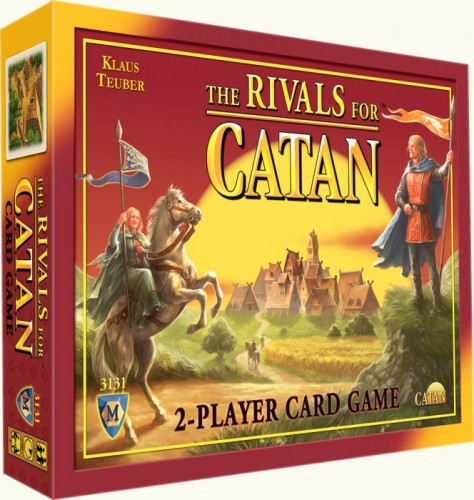
Today we’re going to look at Rivals of Catan. Based off the wildly popular Settlers of Catan this game gives a new twist to the premise. Instead of 3-4 (or 5-6 with expansion) people competing for domination of a hexagonal island, two players are competing to develop their territory. We’ll just assume they also live on a hexagonal shaped island.
The premise of each turn is the same. You roll a die and get resources based on that die roll. One nice thing about this version is that you will gain resources on every die roll. Your starting domain consists of six territories, covering the six resources (Wool, Wood, Brick, Ore, Wheat and Gold) in the game, each with a different number. Unlike Settlers you’ll always get something with each dice roll. This helps keep the game flowing and avoids the periods of, “well, no resources, again, so I’m doing nothing, again” that can happen in Settlers.
While you are only rolling a single d6 to determine resources, the game has a secondary die as well. On this die are several secondary effects that can alter what happens each turn. Since it’s not possible to roll a 7 with a d6, the brigands have their own symbol on the die. Fortunately, the rest of the symbols usually give you, your opponent or both of you a bonus resource or flip an Event card.
Using these resources you build familiar things such as roads, settlements and cities. Unlike Settlers, there are a lot more things you can build. Among the basic buildings you can construct are ones that double production of tiles. For instance, you can build an iron foundry next to an Ore tile and when that number is rolled, you get two ore instead of one. This works great if you can manage to put it between two Ore tiles.
The goal is the same as Settlers, be the first to reach the designated number of victory points. The basic game sets this at 7 which is pretty easy to reach since you start out with two from your two settlements. You gain points by building more settlements, cities and certain special buildings. You can also build an army or a fleet of trade ships to gain the Strength or Trade advantage, each worth one victory point.
You may have noticed my mentioning the “basic” game a few times. That’s because the box comes with three themed sets. These theme sets (Era of Turmoil, Progress and Gold) add a bunch of new cards to the game. These cards are flavored to their particular theme. The Progress set for instance is very peaceful and adds a lot of new buildings, such as the University. Turmoil, on the other hand, adds things like Archers and Arsonists which can remove units and buildings from your opponents realm.
You can play these themed sets separately or together. In addition to increasing the required victory points to 12, making a game last longer, they do a lot to change the feel of the game, giving it a lot of replay value. Of course, there are also several expansions you can purchase which add even more. We haven’t tried those, yet, because the three in the base game provide a good level of variance.
Of the two player games my wife and I own, this is by far our favorite. It’s more involved than many two player games without going overboard and each time you play its a different experience.
Wayne Basta
Latest posts by Wayne Basta (see all)
- X-Wing Tier List – Rebels - May 10, 2023


Thanks for this post Wayne! Somehow this one flew under my radar. I’ve managed to get our whole family hooked on Settlers of Catan & Catan Junior (wife + 16,14,11 & 9 year olds). This looks like a good one for when only 2 of us are available to play.